Storybooks hold a special place in childhood development, offering more than just entertainment. They serve as powerful tools that can shape young minds, influence emotional growth, and foster cognitive development. The simple act of reading a story can have profound effects on a child’s imagination, empathy, and understanding of the world. Here’s an exploration of how storybooks play a crucial role in shaping childhood development.
### **1. Cognitive Development**
**Enhancing Language Skills**
Storybooks are instrumental in developing language skills. From an early age, children exposed to books learn new words, sentence structures, and grammatical concepts.
– **Vocabulary Expansion:** Regular reading introduces children to a richer vocabulary than they might encounter in everyday conversation.
– **Comprehension Skills:** Listening to and discussing stories improves a child’s ability to understand and interpret language, enhancing their comprehension skills.
**Boosting Imagination and Creativity**
Books ignite a child’s imagination, allowing them to explore new worlds and ideas.
– **Creative Thinking:** Storybooks often feature imaginative settings and characters, encouraging children to think creatively and visualize concepts beyond their immediate environment.
– **Problem-Solving:** Many stories present characters with challenges and solutions, prompting children to think critically about how problems can be solved.
### **2. Emotional and Social Development**
**Building Empathy**
Reading stories with diverse characters and situations helps children develop empathy and understanding for others.
– **Relatable Characters:** Children learn to relate to characters’ feelings and experiences, which can foster empathy and emotional intelligence.
– **Perspective-Taking:** Stories provide opportunities for children to see the world from different perspectives, helping them understand and respect diverse viewpoints.
**Understanding Emotions**
Storybooks often address a range of emotions and social situations, helping children navigate their own feelings and interactions.
– **Emotional Regulation:** By observing characters handle various emotions, children can learn strategies for managing their own feelings.
– **Social Skills:** Stories that include social interactions, such as friendships and conflicts, offer valuable lessons in communication, cooperation, and problem-solving.
### **3. Moral and Ethical Development**
**Teaching Values**
Many storybooks impart moral lessons and ethical values, guiding children’s understanding of right and wrong.
– **Moral Lessons:** Stories often include moral dilemmas or lessons about honesty, kindness, and respect, helping children develop a sense of ethical behavior.
– **Role Models:** Characters who exhibit positive traits serve as role models, illustrating desirable behaviors and values.
**Cultural Understanding**
Books can introduce children to various cultures and traditions, promoting cultural awareness and acceptance.
– **Diverse Stories:** Stories from different cultures offer insights into customs, traditions, and lifestyles, helping children appreciate diversity.
– **Global Awareness:** Exposure to international stories broadens children’s understanding of the world and fosters a sense of global citizenship.
### **4. Academic and Intellectual Growth**
**Foundation for Learning**
Storybooks lay the groundwork for academic success by enhancing various cognitive skills.
– **Early Literacy:** Reading fosters early literacy skills, including letter recognition, phonemic awareness, and reading fluency.
– **Knowledge Acquisition:** Many books introduce concepts related to science, history, and social studies, enriching children’s knowledge base.
**Critical Thinking**
Complex narratives and characters encourage critical thinking and analytical skills.
– **Story Analysis:** Discussing story plots, characters, and themes helps children practice critical thinking and reasoning.
– **Prediction and Inference:** Predicting story outcomes and inferring characters’ motivations develop analytical skills and comprehension.
### **5. Practical Tips for Parents and Educators**
**Choosing the Right Books**
Selecting age-appropriate and diverse books is essential for maximizing the benefits of storytelling.
– **Variety of Genres:** Include a mix of fiction, non-fiction, and poetry to expose children to different writing styles and topics.
– **Interactive Books:** Books with interactive elements, such as flaps or textures, can engage young readers and enhance their learning experience.
**Encouraging Reading**
Creating a positive reading environment supports a child’s love for books.
– **Read Aloud:** Reading aloud to children helps build their listening skills and fosters a love for stories.
– **Storytelling Time:** Establish a regular reading routine, making storytelling a cherished part of daily life.
**Engaging in Discussions**
Discussing the stories read encourages deeper understanding and reflection.
– **Ask Questions:** Encourage children to think critically by asking questions about the story’s plot, characters, and themes.
– **Relate to Real Life:** Connect the story’s lessons to real-life situations, helping children apply what they’ve learned.
### **Conclusion**
Storybooks are far more than just delightful tales; they are vital tools for shaping childhood development. From enhancing cognitive skills and emotional growth to teaching values and fostering creativity, the impact of reading on a child’s development is profound and far-reaching. By embracing the magic of storytelling and choosing the right books, parents and educators can nurture a child’s imagination, empathy, and intellectual curiosity, laying a strong foundation for a lifetime of learning and growth.




